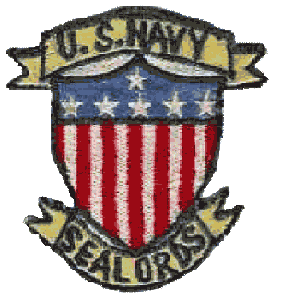
| The SEALORDS Campaign |
| October 1968 - December 1970 |

|
From 1968 to 1971, as U.S. forces prepared the South Vietnamese military to assume complete responsibility for the war, they also
worked to keep pressure on the enemy by following up on and exploiting the Communists' staggering battlefield losses during the 1968
Tet Offensive attacks
The Navy, in particular, spearheaded a drive in the Mekong Delta to isolate and destroy the weakened Communist forces. The SEALORDS
(Southeast Asia Lake, Ocean, River, and Delta Strategy) campaign was a determined effort by U.S. Navy, South Vietnamese Navy, and allied
ground forces to cut enemy supply lines from Cambodia, and disrupt operations in his base areas deep in the Mekong Delta. This strategy
was developed by Commander Naval Forces Vietnam (COMNAVFORV), Vice Admiral Elmo R. Zumwalt Jr, after taking command in late 1968 and
with the blessing of the also new Commander US Military Assistance Command Vietnam (COMUSMACV), General Creighton Abrams
|
|
In order to focus the allied effort on the SEALORDS campaign, COMNAVFORV initially appointed Captain Robert S. Salzer, Commander of the Riverine Assault Force, as the operational commander or "First SEALORD" of the newly activated Task Force 194. When Salzer completed his Vietnam tour two months later, Rear Admiral William House, Deputy COMNAVFORV, assumed this role and established headquarters in the Mekong Delta city of Can Tho. Although continuing to function, the Market Time (TF115), Game Warden (TF116), and Riverine Assault Force (TF117) operations were scaled down and their personnel and material resources increasingly devoted to SEALORDS. |
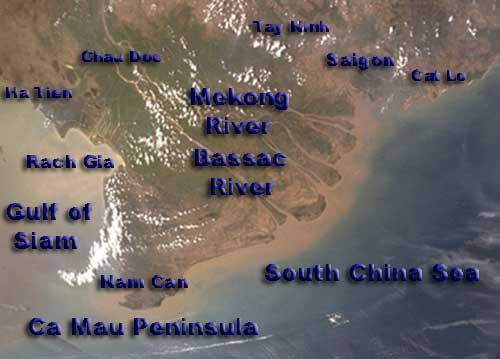 |
To kick off SEALORDS, Market Time (TF115) Swift Boats initiated the "Market Time Raider" program which mounted lightning raids into enemy held coastal waterways and took over patrol responsibility for the Southern Delta's larger rivers. This freed up the smaller PBRs (Patrol Boat River) for operations along the previously uncontested shallow tributaries and canals. These intrusions into former Viet Cong bastions were possible only with the on-call support of naval aircraft and the heavily armed and armored Riverine Assault Force craft |
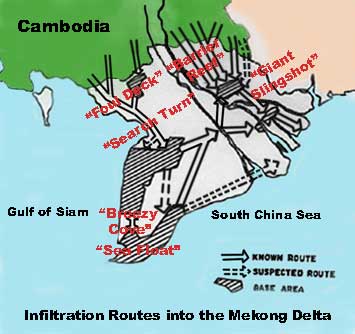 |
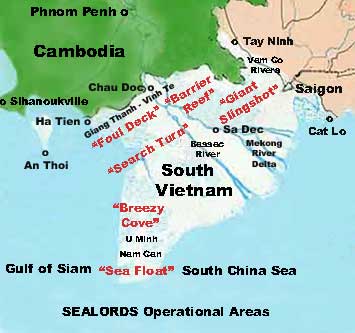 |
In the first phase of the SEALORDS campaign, allied forces established multiple patrol "barriers," often suplemented with electronic sensor devices, all along the waterways paralleling the Cambodian border west of Saigon: |
In early November 1968, PBRs and Riverine Assault Craft opened two canals between the Gulf of Siam at Rach Gia and the Bassac River at Long Xuyen in an operation assigned the name Search Turn. Vietnamese ground troops helped Game Warden (TF116), and Riverine Assault Force (TF117) units secure the transportation routes on these important commercial waterways. The sucess of the operation proved out the concept of utilizing combined naval and land forces to form a successful interdiction barrier to enemy infiltration from across the Cambodian border into the southern Ca Mau peninsula Later in the month, in operation Foul Deck, Swift Boats, PBRs, Riverine Assault Craft, and Vietnamese naval vessels penetrated the Giang Thanh River-Vinh Te Canal system, north of Search Turn and nearer to the Cambodian border, to establish patrols all along that waterway from Ha Tien on the Gulf of Siam to Chau Doc on the upper Bassac. Then in December, against heavy enemy opposition, U.S. Naval forces pushed up the Vam Co Dong (Vam Co East) and Vam Co Tay (Vam Co West) Rivers west of Saigon to cut infiltration routes on either side and south of the "Parrot's Beak" area of Cambodia. This Giant Slingshot operation, so named for the Y-shape of the confluence of the two rivers on a map, severely hampered Communist resupply in the region near the capital and in the Plain of Reeds. Completing the first phase of the SEALORDS program, in January 1969, PBRs, Assault Support Patrol Boats (ASPB), and other river craft established patrol sectors along the Kanh Xang (Grand Canal) westward from the Vam Co Tay River over the Plain of Reeds to the Mekong River at An Long in operation Barrier Reef. |
|
So by the end of the first four months of SEALORDS, patrolled waterway interdiction barriers had been established that extended
uninterrupted from Tay Ninh northwest of Saigon all the way to the Gulf of Siam at
Ha Tien and Rach Gia.
During 1969 the second phase of SEALORDS was expanded as pacification efforts to additional regions of Vietnam, principally in I Corps in the far north and the most remote reaches of the Mekong Delta at the southern tip of Vietnam inside the Ca Mau Peninsula. |
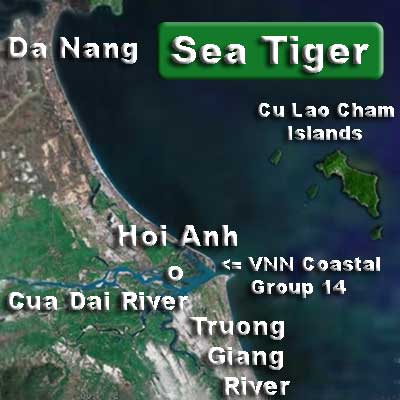 |
In February 1969, pacification efforts in I Corps were initiated by Vietnamese Coastal Group 14 Yabutas and Coastal Division 12 Swift Boats on the Cua Dai River south of Da Nang and west of Hoi An in Quang Nam Province. Although remaining under the auspices of TF115, this operation was very much a vital part of the SEALORDS campaign strategy and, with the much later inclusion of PBRs from TF116, became known as Operation Sea Tiger |
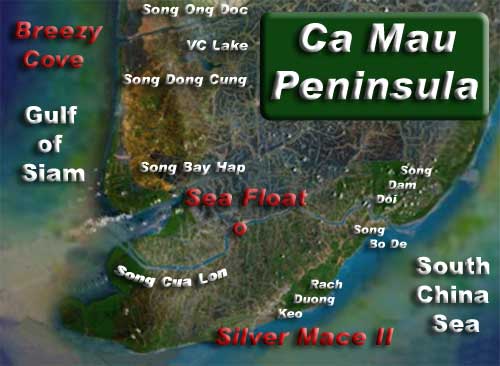 |
In the Mekong Delta, Swift Boat, PBR, Riverine Assault Craft, SEAL, and Vietnamese ground units struck at the Viet Cong in their former strongholds, which included the Ca Mau Peninsula, the U Minh Forest, and the islands of the broad Mekong River system. From April 7 to 18, the ground - air - and naval units from each of the American services, the Vietnamese Navy, and the Vietnamese Marine Corps conducted Silver Mace II, a strike operation in the Nam Can Forest on the Ca Mau Peninsula. Fierce fighting erupted with the northern forces that occupied the narrow Duong Keo River - (also see "The Death of PCF 43") - but the enemy's operations were significantly disrupted. Based on the lessons learned by such forays into the enemy held strongholds of this southern most region of South Vietnam, the SEALORDS leaders came up with an extrordinary and very innovative way to secure a more permanent Vietnamese government presence in this vital area. In June 1969, the Navy first assembled, then transported, a mobile pontoon base anchored in the middle of the Ca Mau region's Cua Lon River. Called Sea Float, this operation was made difficult by very heavy Communist opposition, strong river currents, and the distance to logistic support facilities. Still, this "floating fortress" denied the enemy a safe haven even in this very isolated corner of the delta. By the end of 1969, the area was secure enough to allow a land base, named Solid Anchor, to begin to be established adjacent to the floating facility anchored just off the town of Nam Can. Later in 1969, the allies further threatened the Communists in this active area when they set up raids and barrier patrols along the Song Ong Doc, a river on the southern border of the dense and isolated U Minh area. Staging from what was known as a Mobile Advanced Tactical Support Base (MATSB) at the river's mouth, U.S. and Vietnamese PBRs and Swift Boats of operation Breezy Cove repeatedly intercepted and destroyed enemy supply convoys crossing this waterway. |
One year after the start of the SEALORDS campaign, Communist military forces in the Mekong Delta were under heavy pressure. The successive border interdiction barriers had delayed and disrupted the enemy's arms resupply and troop replacement efforts from Cambodia. The raiding operations had hit vulnerable base areas. And the Sea Float and Sea Tiger deployments had pacified areas deep in what had once been Viet Cong sanctuaries. Although costly in allied casualties, the campaign had proved to be highly successful as a potential war winning strategy. |
Perhaps the culmination of the SEALORDS campaign was inclusion of US and Vietnamese naval forces in the incursion into Cambodia to finally take the interdiction efforts of the allies directly to the source of the movement of arms, material and troops into the southern areas of Vietnam. The total Cambodian operation was authorized by President Nixon and carried out starting in May of 1970. The naval part of this operation was known as Tran Hang Dao XI and had the goal of clearing the Mekong River all the way to Phnom Penh and to cut the supply line near the Cambodian town of Neak Loeang. This was carried out with great success, as was the entire Cambodian incursion, halting infiltration activities from this region until political pressure in the United States forced an end to the operation. Another fall out of this increasing political pressure was a reorganization, in June 1970, of the United States and Vietnamese naval forces to comply with the fast moving process of Vietnamization. Only a few of the SEALORDS operations were reassigned back under Game Warden (TF116) designations. But the rest were turned over to the South Vietnamese Navy as quickly as possible. |
|
By the end of 1970, only Solid Anchor remained under American command, and that was turned over on the first of April 1971, marking an end to direct US Navy control of operations inside South Vietnam. |
This web site is Copyright � 2002 by Robert B. Shirley. All rights reserved. Click on image to return to the homepage
|